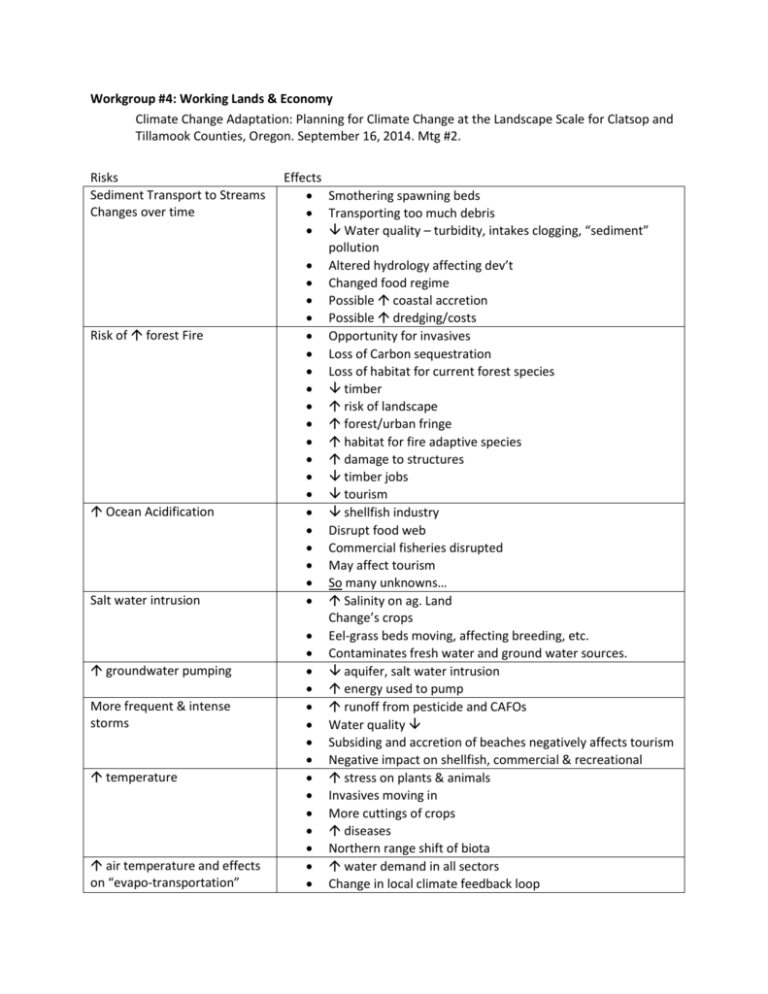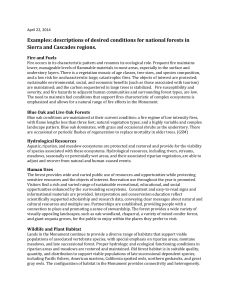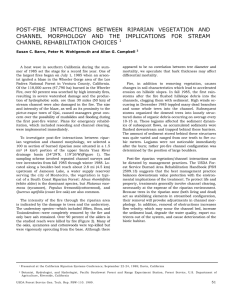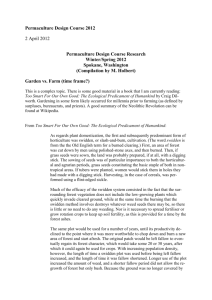Workgroup #4: Working Lands and Economy Mgmt Obj.
advertisement

Workgroup #4: Working Lands & Economy Climate Change Adaptation: Planning for Climate Change at the Landscape Scale for Clatsop and Tillamook Counties, Oregon. September 16, 2014. Mtg #2. Risks Sediment Transport to Streams Changes over time Risk of forest Fire Ocean Acidification Salt water intrusion groundwater pumping More frequent & intense storms temperature air temperature and effects on “evapo-transportation” Effects Smothering spawning beds Transporting too much debris Water quality – turbidity, intakes clogging, “sediment” pollution Altered hydrology affecting dev’t Changed food regime Possible coastal accretion Possible dredging/costs Opportunity for invasives Loss of Carbon sequestration Loss of habitat for current forest species timber risk of landscape forest/urban fringe habitat for fire adaptive species damage to structures timber jobs tourism shellfish industry Disrupt food web Commercial fisheries disrupted May affect tourism So many unknowns… Salinity on ag. Land Change’s crops Eel-grass beds moving, affecting breeding, etc. Contaminates fresh water and ground water sources. aquifer, salt water intrusion energy used to pump runoff from pesticide and CAFOs Water quality Subsiding and accretion of beaches negatively affects tourism Negative impact on shellfish, commercial & recreational stress on plants & animals Invasives moving in More cuttings of crops diseases Northern range shift of biota water demand in all sectors Change in local climate feedback loop Risks Reduced summer base flows in late summer Shifts in upwelling regime Conversion of grasslands to row crops climate refugees to Oregon Effects habitat Fewer deep pools temperature water for irrigation and municipalities Water rights conflicts Urban/rural fights drying of fuels in riparian areas More people in rivers at low flow may exacerbate water quality Reduces fish productivity hypoxia acidification carbon dioxide fuel consumption from tilling soil Water hungry crops fertilizer use sedimentation Less resilient crops to climate change ALL pressures noted The workgroup then focused in on a few of the risks identified above to think about management objectives to address those risks. Risk: Erosion & Sedimentation Effects: above Management Objectives: “protective riparian buffers” trap and slow down and filtrate sediment shading “protect, enhance, restore buffers” o Incintivise Different logging practices on steep slopes “disturbance” Confluence of objectives Increasing watershed integrity, resilience to disturbance Change building practices to minimize erosion/sedimentation Land practices in ag. (no till, drought adapted crops) – increase rotation of crops More forest burns erosion Risk: Increased forest fires Effects: above Management Objectives: Reduce fuels to fires through thinning Create job … using biofuels from thinning Increase diversity of forest species Adapt reforestation species to new conditions Maintaining buffer zones and forest canopy undisturbed Keeping people (1° ignition source) out in fire season. Improve fire forecasting tools, both short-term forests and seasonal fire risks, etc. Improve accuracy and lead-time of climate systems to anticipate fire potentials. expectation of humans to know the future weather Education people about variability and the “unknowns” Risk: Reduced base flows, seasonal extremes of rivers Effects: above Management Objectives: Plant drought resistant species water storage, conservation Research water-year data to anticipate trends, leads to more resilient water practices Change financial incentives to change consumptive patterns. Regionalization of water systems and treatment to resilience and buffer Diversify municipal and ag water sources o Take less from more sources riparian buffers fish passage at damns to maximize benefit (to accommodate water change) Water catchment and rain gardens Maximum use of technology for water supply and delivery “Healthy watersheds and rivers” Using best technology spreads across all management objectives – data collection, monitoring, etc.











